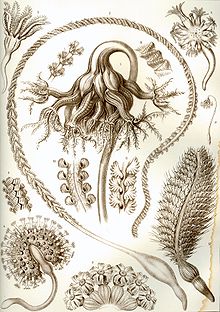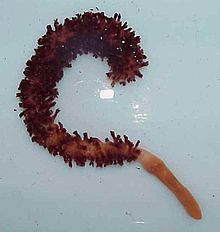- Sea pen
-
For other uses, see Pen (disambiguation).
Sea pens
Temporal range: Cambrian–Recent
"Pennatulida" from Ernst Haeckel's Kunstformen der Natur, 1904 Scientific classification Kingdom: Animalia Phylum: Cnidaria Class: Anthozoa Subclass: Octocorallia Order: Pennatulacea
Verrill, 1865Families - Suborder Sessiliflorae
- Anthoptilidae
- Chunellidae
- Echinoptilidae
- Funiculinidae
- Kophobelemnidae
- Protoptilidae
- Renillidae
- Scleroptilidae
- Stachyptilidae
- Umbellulidae
- Veretillidae
- Suborder Subselliflorae
- Pennatulidae
- Pteroeididae
- Virgulariidae
Sea pens are colonial marine cnidarians belonging to the order Pennatulacea. There are 14 families within the order; they are thought to have a cosmopolitan distribution in tropical and temperate waters worldwide. Sea pens are grouped with the octocorals ("soft corals"), together with sea whips and gorgonians.
Although named after their feather-like appearance reminiscent of antique quill pens, only sea pen species belonging to the suborder Subselliflorae live up to the comparison. Those belonging to the much larger suborder Sessiliflorae lack feathery structures and grow in club-like or radiating forms. The latter suborder includes what are commonly known as sea pansies.
The sea pen fossil record is patchy and disputed by some[who?]; while the earliest accepted fossils are known from the Cambrian-aged Burgess Shale (Thaumaptilon), similar fossils from the Ediacaran (ala Charnia) may represent the dawn of sea pens. Precisely what these early fossils are, however, is not decided.
Contents
Biology
As octocorals, sea pens are colonial animals with multiple polyps (which look somewhat like miniature sea anemones), each with eight tentacles. Unlike other octocorals, however, a sea pen's polyps are specialized to specific functions: a single polyp develops into a rigid, erect stalk (the rachis) and loses its tentacles, forming a bulbous "root" or peduncle at its base.[1] The other polyps branch out from this central stalk, forming water intake structures (siphonozooids), feeding structures (autozooids) with nematocysts, and reproductive structures. The entire colony is fortified by calcium carbonate in the form of spicules and a central axial rod.
Using their root-like peduncles to anchor themselves in sandy or muddy substrate, the exposed portion of sea pens may rise up to 2 metres (6.6 ft) in some species, such as the tall sea pen (Funiculina quadrangularis). Sea pens are sometimes brightly coloured; the orange sea pen (Ptilosarcus gurneyi) is a notable example. Rarely found above depths of 10 metres (33 ft), sea pens prefer deeper waters where turbulence is less likely to uproot them. Some species may inhabit depths of 2,000 metres (6,600 ft) or more.
While generally sessile animals, sea pens are able to relocate and re-anchor themselves if need be.[1] They position themselves favourably in the path of currents, ensuring a steady flow of plankton, the sea pens' chief source of food. Their primary predators are nudibranchs and sea stars, some of which feed exclusively on sea pens. When touched, sea pens emit a bright greenish light; this is known as bioluminescence. They may also force water out of themselves as a defensive act, deflating and retreating into their peduncle.
Like other anthozoans, sea pens reproduce by co-ordinating a release of sperm and eggs into the water column; this may occur seasonally or throughout the year. Fertilized eggs develop into larvae called planulae which drift freely for about a week before settling on the substrate. Mature sea pens provide shelter for other animals, such as juvenile fish. Analysis of rachis growth rings indicates sea pens may live for 100 years or more, if the rings are indeed annual in nature.
Gallery
-
Sea pen at Vancouver Aquarium
-
Orange Sea Pen (Ptilosarcus gurneyi) at Monterey Bay Aquarium, California
External links
References
Corals and coral reefs Stony corals 
Soft corals - Alcyonacea
- Black coral
- Bamboo coral
- Organ pipe coral
- Sea fans
- Sea pens
Coral reefs - Atoll reef
- Cay
- Fringing reef
- Microatoll
- Coral reef fish
- Census of Coral Reefs
- The Structure and Distribution of Coral Reefs
Coral regions Coral diseases - Coral bleaching
- Black band disease
- Skeletal eroding band
- White band disease
- White pox disease
Protection - Coral reef protection
- Project AWARE
- Reef Check
- Reef Ball
- Coral Reef Alliance
- International Society for Reef Studies
Other - Artificial reef
- Coral aquaculture
- Coral dermatitis
- Coral (precious)
- Coral rag
- Coral sand
- Coralline algae
- Human impact
- Fire coral
- Rugosa (extinct)
- Tabulate (extinct)
- Zooxanthella
Categories:- Pennatulacea
- Bioluminescent organisms
- Suborder Sessiliflorae
Wikimedia Foundation. 2010.



